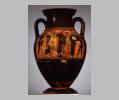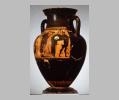| Collection: | University Museum, University of Pennsylvania |
| Summary: | Side A: Dionysos and Athena, with Hermes, a maenad and a satyr |
| Ware: | Attic Black Figure |
| Painter: | Near the Priam Painter |
| Context: | Possibly from Chiusi |
| Date: | ca. 525 BC - ca. 500 BC |
| Dimensions: | H. 0.485 m., D. body 0.31 m., D. lip 0.21 m., D. base 0.18 m. |
| Primary Citation: | |
| Shape: | Amphora |
| Region: | Etruria |
| Period: | Archaic |
Condition:
The amphora is worn and some portions are discolored. In some places the paint has been worn off completely.
Decoration Description:
Side A: Dionysos and Athena, with Hermes, a maenad and a satyr. Dionysos stands in the center facing Athena on the right. He is followed by a maenad and a flute-playing satyr, while Hermes accompanies Athena. Dionysos is holding a kantharos in his raised left hand and has his right hand hidden under his mantle. He wears a wreath of grape leaves. Athena faces Dionysos holding two spears and a shield which hides her body from neck to hip. The shield has a central boss of five white leaves. Athena is helmeted and wears a long black gown with a decorative border. Behind Athena, Hermes, in winged boots, striped chlamys and petasos, walks to the right looking back toward Athena on the left. On the left, behind Dionysos, is a maenad dressed in a belted peplos and crowned with a wreath of grape leaves. She wears her long hair loose down her back. A satyr prances behind her on the far left playing the double flute, one knee raised almost to his chest. He is naked, bearded, and has pointed ears and a long tail. A grape vine surrounds Dionysos, the maenad and the satyr.
Side B: four satyrs carrying four maenads. Four ithyphallic satyrs dance to the right, carrying music-playing maenads. The satyr on the right leads the way, prancing with one leg off the ground as he lifts the maenad by her waist. She faces him and the rest of the procession, raising her right hand as if to cheer them on. The second couple follows close behind, the satyr crouching down with the maenad on his shoulder. He is looking back over his shoulder to the third couple on the left. The maenad is playing a double flute, her head bent forward as she plays. The third satyr stands with feet together and legs bent, carrying a maenad on his shoulder. She is playing a lyre and looks back toward the last couple on the far left. The fourth satyr prances to the right but looks left. His right arm hangs by his side and his left is draped over the thighs of the maenad sitting on his shoulder. Like the second maenad, she plays a double flute. All the maenads wear long, black, belted chitons and have long hair crowned by wreaths of grape leaves. The satyrs have long hair and beards, pointed ears, and long tails. There is a grape vine in the background.
Shape Description:
Type B amphora. A lid, MS2462B, was originally attributed to this amphora, but in June, 1965, von Bothmer gave his opinion that the lid did not belong with MS2462A.
Collection History:
The vase was purchased by Phoebe A. Hearst from Davis and Harvey, and was subsequently given to the University Museum, Philadelphia.





